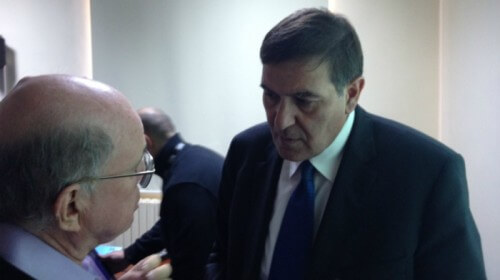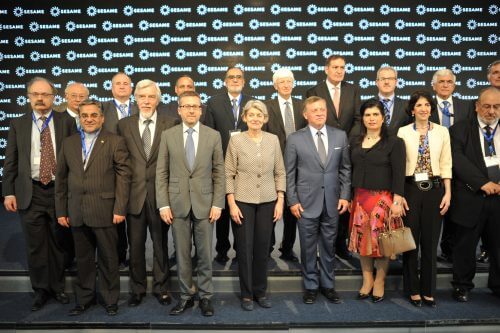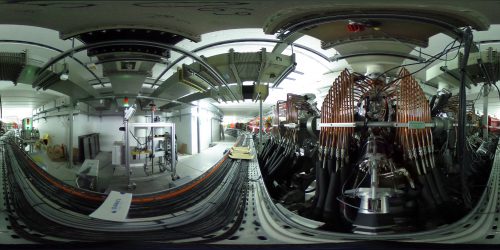In an interview with the Hidan website, Prof. Rabinowitz said: "The very establishment of the accelerator shows that it is possible for scientists from different countries in the region to work together for twenty years, despite the ups and downs on the political level."

Five scientists who made key contributions to the establishment and development of the SESAME synchrotron accelerator for the Middle East Experimental and Applied Science Laboratory have been selected by the American Association for the Advancement of Science to receive its 2019 Science Diplomacy Award from the American Association for the Advancement of Science (AAAS), which is also the publisher of the journal Science.
The scientists sharing the award are Prof. Eliezer Rabinowitz from the Hebrew University in Jerusalem, Khaled Toukan - Chairman of the Atomic Energy Commission of Jordan, Zohra Sayers, a biophysicist from Sevansi University in Istanbul, Herwig Schoffer - an experimental physicist from the University of Hamburg, and Christopher Luan Smith, a theoretical researcher in the field of particle physics at the University of Oxford. The last two were directors of CERN.
"This institution has resulted in an unprecedented level of scientific cooperation between political rivals in a region that previously lacked an important international research center," read the judges' reasoning. SESAME was officially inaugurated in May 2017 in Alan, Jordan and is considered the first international scientific center in the Middle East, the establishment of the project and its ongoing success would not have been possible without the efforts of the five interviewees."
In an interview with the Hidan website, Prof. Rabinowitz informed that despite the accelerator itself being inaugurated in May 2017, the accelerator's construction and testing continued until recently. "The accelerator has two light sources that can be used for experiments, under a project known as Beam Line. Dozens of researchers have submitted applications for research at the synchrotron, including researchers from Israel, and the experiments to be carried out will be selected in a scientific competitive manner.
"It is important to note that all the Israeli government agencies were partners in the effort for this accelerator to be established. Ministry of Science, Ministry of Foreign Affairs, National Academy of Sciences, Ministry of Finance, Ministry of Regional Cooperation. Everyone contributed to this. It is a very pleasant feeling to see that it is possible in the State of Israel to make everyone work together for a common goal.
"The very establishment of the accelerator shows that it is possible for scientists from different countries in the region to work together for twenty years, despite the ups and downs on the political level. that to a certain extent the scientists took the governments to a place they and I did not think they would ever reach but when they did they did not blink. This is proof that there is another way. There is no illusion that it will make a dramatic change in the area, there are much bigger forces, but at least we contributed our part."
What is the importance of the award?
"The prize is awarded by the American Organization for the Advancement of Science, which is an old and important organization and has 120 members, among the recipients of the prize in the past is the American ambassador Thomas Pickering. The importance of the award is international recognition of the work we are doing and in support of the scientists' desire to work together for a common goal for their nations and for all of humanity."
In conclusion, Prof. Rabinowitz said: After the stage where we showed that the rival countries can for a common goal, we showed that it can happen. The next step will be that we will be tested according to the science and my great hope is that high-level science can be done there and that in the future there will be findings that we can be proud of because they are the product of experiments developed at SESAME. It has potential.
The judges also reasoned: SESAMI is an exceptional example of how scientists can unite around knowledge among countries known for long-term political tensions, said AAAS CEO Rush Holt. "The scientific enterprise in itself can promote peace and foster international cooperation." Accelerator members are Cyprus, Egypt, Iran, Israel, Jordan, Pakistan, the Palestinian Authority and Turkey.

The synchrotron accelerators create a strong beam of light that can reveal the atomic structure of matter, making them a valuable tool in biology, chemistry, archeology and more. A month before the opening of SESAME, for example, a synchrotron at the SLAC National Accelerator Laboratory in California revealed new details about the structure of proteins that regulate blood pressure, a discovery that may lead to better blood pressure treatments. This potential for innovative research in diverse fields makes the synchrotron source an ideal tool for the first major scientific facility in the Middle East. At SESAME, teams of researchers from all member countries began to carry out experiments that have the potential to advance the development of diverse scientific fields in their countries of origin.
"In recent years, there is hardly a more prominent example of science diplomacy than SESAME, which testifies to the power of science to build bridges in the face of geopolitical tensions," said Mallet Mespain, deputy director of the AAAS Center for Science and Diplomacy. "The dedicated leaders we recognize with this award have played a critical role in overcoming many obstacles – diplomatic and otherwise – and breathing life into this research facility."
The beginning of the project with researchers from the region, from Germany, the USA and Israel who wanted to establish in the Middle East an accelerator similar in terms of its human goals to those of the accelerator at CERN. In 1997, the Ministry of Science and the National Academy of Sciences joined the initiative, based on the concept that scientific cooperation in the region would not only benefit scientific development but also lead to mediation and understanding between the countries of the Middle East. In 2003 the cornerstone was laid for the facility and in November 2008 the construction of the building that will house the particle accelerator was completed. In addition to the member states of the accelerator, the European Union, Italy, UNESCO and Germany donated millions of dollars to the project and laboratories from around the world donated scientific equipment worth an additional 20 million dollars. Over the years, Israel has invested about NIS 40 million in the construction of the accelerator.
Sesame's scientific goals are different from those of the accelerator in Geneva. The seven light beams that will work in the accelerator, two of which are already working, will allow scientists to study the properties of different materials. The first beam of light to operate will be used to study air pollution in the Jordan Valley by examining the presence of metals in soil samples. Another beam will provide radiation waves that will make it possible to study cancer cells and other biological tissues.
There are about 60 similar particle accelerators in the world. SESAME is a modern, innovative accelerator and the only one of its kind in the Middle East. Israeli scientists and research students are expected to use the infrastructure offered by the accelerator in the coming years. For the comfort of the researchers, dormitories for the scientists who will stay there will also be built next to the accelerator.

